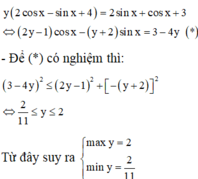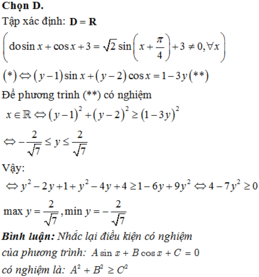
Hãy nhập câu hỏi của bạn vào đây, nếu là tài khoản VIP, bạn sẽ được ưu tiên trả lời.


y = \(\dfrac{sin^2x}{cosx\left(sinx-cosx\right)}+\dfrac{1}{4}\)
y = \(\dfrac{sin^2x}{sinx.cosx-cos^2x}+\dfrac{1}{4}=\dfrac{\dfrac{sin^2x}{cos^2x}}{\dfrac{sinx.cosx}{cos^2x}-1}+\dfrac{1}{4}\)
y = \(\dfrac{tan^2x}{tanx-1}+\dfrac{1}{4}\)
y = \(\dfrac{4tan^2x+tanx-1}{4tanx-4}\). Đặt t = tanx. Do x ∈ \(\left(\dfrac{\pi}{4};\dfrac{\pi}{2}\right)\) nên t ∈ (1 ; +\(\infty\))\
Ta đươc hàm số f(t) = \(\dfrac{4t^2+t-1}{4t-4}\)
⇒ ymin = \(\dfrac{17}{4}\) khi t = 2. hay x = arctan(2) + kπ

a, Đồ thị hàm số \(y=cosx\): \(\left(A=\left(-\dfrac{\pi}{2};0\right);B=\left(\dfrac{\pi}{2};0\right)\right)\)
Dựa vào đồ thị ta có \(\left\{{}\begin{matrix}y_{min}=0\\y_{max}=1\end{matrix}\right.\)
b, Đồ thị hàm số \(y=sinx\): \(\left(A=\left(-\dfrac{\pi}{2};-1\right);A=\left(\dfrac{\pi}{2};1\right)\right)\)

Đặt \(sinx+cosx=t\Rightarrow-\sqrt{2}\le t\le\sqrt{2}\)
\(t^2=sin^2x+cos^2x+2sinx.cosx=1+2sinx.cosx\Rightarrow sinx.cosx=\dfrac{t^2-1}{2}\)
\(\Rightarrow y=t+\dfrac{t^2-1}{2}=\dfrac{1}{2}t^2+t-\dfrac{1}{2}\)
Xét hàm \(f\left(t\right)=\dfrac{1}{2}t^2+t-\dfrac{1}{2}\) trên \(\left[-\sqrt{2};\sqrt{2}\right]\)
\(-\dfrac{b}{2a}=-1\)
\(f\left(-\sqrt{2}\right)=\dfrac{1-2\sqrt{2}}{2}\) ; \(f\left(-1\right)=-1\) ; \(f\left(\sqrt{2}\right)=\dfrac{1+2\sqrt{2}}{2}\)
\(\Rightarrow y_{min}=-1\) khi \(t=-1\) ; \(y_{max}=\dfrac{1+2\sqrt{2}}{2}\) khi \(t=\sqrt{2}\)
Đặt \(t=sinx+cosx;t\in\left[-\sqrt{2};\sqrt{2}\right]\)
\(\Rightarrow\dfrac{t^2-1}{2}=sinx.cosx\)
\(y=t+\dfrac{t^2-1}{2}=\dfrac{t^2}{2}+t-\dfrac{1}{2}\)
Vẽ BBT của \(f\left(t\right)=\dfrac{t^2}{2}+t-\dfrac{1}{2};t\in\left[-\sqrt{2};\sqrt{2}\right]\)
\(\Rightarrow\)\(f\left(t\right)_{min}=-1\Leftrightarrow t=-1\Rightarrow sinx+cosx=-1\Leftrightarrow sin\left(x+\dfrac{\pi}{4}\right)=-\dfrac{1}{\sqrt{2}}\)....
\(f\left(t\right)_{max}=\dfrac{1+2\sqrt{2}}{2}\)\(\Leftrightarrow t=\sqrt{2}\Rightarrow sinx+cosx=\sqrt{2}\Leftrightarrow sin\left(x+\dfrac{\pi}{4}\right)=1\)....

a.
\(y=sinx.cosx+1=\dfrac{1}{2}sin2x+1\)
\(-1\le sin2x\le1\Rightarrow\dfrac{1}{2}\le y\le\dfrac{3}{2}\)
\(y_{min}=\dfrac{1}{2}\) khi \(sin2x=-1\Rightarrow x=-\dfrac{\pi}{4}+k\pi\)
\(y_{max}=\dfrac{3}{2}\) khi \(sin2x=1\Rightarrow x=\dfrac{\pi}{4}+k\pi\)
b.
\(y=2\left(\dfrac{\sqrt{3}}{2}sinx-\dfrac{1}{2}cosx\right)-2=2.sin\left(x-\dfrac{\pi}{6}\right)-2\)
\(-1\le sin\left(x-\dfrac{\pi}{6}\right)\le1\Rightarrow-4\le y\le0\)
\(y_{min}=-4\) khi \(sin\left(x-\dfrac{\pi}{6}\right)=-1\Rightarrow x=-\dfrac{\pi}{3}+k2\pi\)
\(y_{max}=0\) khi \(sin\left(x-\dfrac{\pi}{6}\right)=1\Rightarrow x=\dfrac{2\pi}{3}+k2\pi\)
















